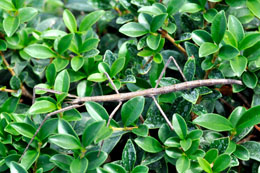What is that lovely vigorous green shrub in the garden? See more about a great landscape shrub called Ligustrum.

I fell in love with it when I saw it in my neighbor's garden simply looking so lush and of a deep healthy green; yes, I am talking about the evergreen
ligustrum. Its waxed leaves that simply look so fresh made me look for it and try to get it for my garden as well. Ligustrum is a shrub or a tree that thrives in the state of Florida, however, there are specific species of the plant that love Europe and Asia as well. They come in many leaf forms and foliage colors as well as with different growth habits. Since they don't mind heavy pruning and they have a rapid growth rate they make great clip hedges.
As mentioned earlier, there are many varieties and among the most common there is the Japanese or wax privet (Ligustrum japonicum), glossy privet (L. lucidum) and Chinese privet (L. sinense). The Japanese privet compact shrub or small tree grows up to 18 feet (5.5 m) tall, but if you don't want it so big, you can prune it to keep it as high as you desire.
Regardless of its exquisiteness, the Glossy privet (L. lucidum) is a fast growing and invasive species and you really need to keep it under control because it will propagate by seeds in your garden taking over the nearby land. Glossy privet reaches up to 40 feet (12 m) in height and its leaves are up to 6 inches long.
Another commonly found species is the Variegated Chinese privet (L. sinense `Variegata') that is as its name implies, a species of ligustrum with white or yellow variegated leaves but sometimes this variety develops branches with completely green leaves. However, the completely green leaves variety is called Chinese privet (L. sinense). Its vigorous and rich foliage almost cover its white flowers in spring time.
Most commonly use in landscaping, ligustrums are preferred due to their rather low cost as well as maintenance and adaptability combined with fast growth. They are most often seen as hedges, patio trees, shrub borders or accent borders. Their wealthy foliage aspect makes them suitable for both formal and informal hedges. Also the ligustrum trees can be kept in large containers suited for their size, thus obtaining a dramatic effect!
To care for your ligustrum bush or tree is not a difficult task, if you have chosen a healthy, strong plant to start with. Apart from pruning to your desired growth, ligustrum doesn't need a lot of fertilization, twice per year would suffice. This should be accomplished in early spring and in the fall.
If you want to propagate your plant that can be done in three different ways: by cuttings, grafting, and seed. You'll have most success if you use the softwood and the spring hardwood cuttings. Look for the actively new growth of the mother plant as those tend to root best. The rooting process takes around 8 weeks and some species root better than others for example Glossy privet occasionally roots harder.
You can also use the seed propagation for Japanese and glossy privet and for that you need to take the fruit (in September- October) without allowing it to reach complete drying and you can plant the seeds (removing the pulp). They should germinate in 30-60 days.
Although they are very resistant plants, ligustrums have some reputable enemy in aphids (plant lice that suck the juices of the plant causing curved leaves especially in new growth), spidermites, scales, as well as whiteflies. A good insecticide will prevent these problems if applied before the leaves curl that means from the very start when you see those little green or black lice come to life. Just as with lice, scales and white fly can also be removed by spraying with insecticide.
Not only bugs but also fungi can attack this plant and you can observe light to dark brown spots on the leaves causing premature leaf drop. For control applying fungicide, removing and destroying the infected leaves is a must.
The roots of ligustrum can also be affected by organisms that cause rot and disease but the infected plants cannot be saved if their roots are not functional any longer.
To sum up, this plant offers a lovely site, it is inexpensive and can suit all tastes due to the large variety it can be found in. If you already have it, enjoy it, if not, maybe you fall in love with it as I did!






 I fell in love with it when I saw it in my neighbor's garden simply looking so lush and of a deep healthy green; yes, I am talking about the evergreen ligustrum. Its waxed leaves that simply look so fresh made me look for it and try to get it for my garden as well. Ligustrum is a shrub or a tree that thrives in the state of Florida, however, there are specific species of the plant that love Europe and Asia as well. They come in many leaf forms and foliage colors as well as with different growth habits. Since they don't mind heavy pruning and they have a rapid growth rate they make great clip hedges.
I fell in love with it when I saw it in my neighbor's garden simply looking so lush and of a deep healthy green; yes, I am talking about the evergreen ligustrum. Its waxed leaves that simply look so fresh made me look for it and try to get it for my garden as well. Ligustrum is a shrub or a tree that thrives in the state of Florida, however, there are specific species of the plant that love Europe and Asia as well. They come in many leaf forms and foliage colors as well as with different growth habits. Since they don't mind heavy pruning and they have a rapid growth rate they make great clip hedges.